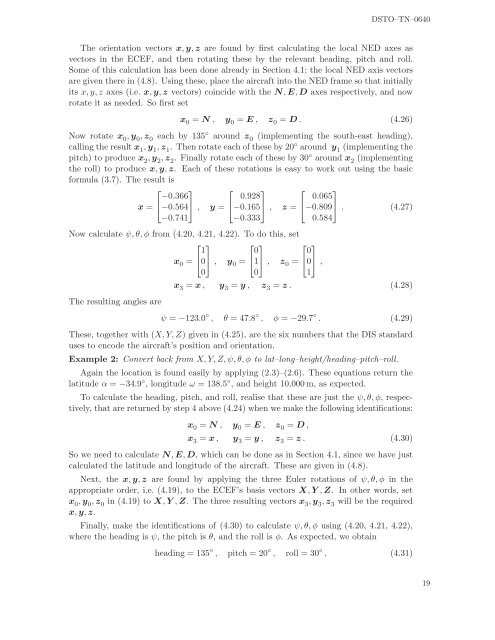Using Rotations to Build Aerospace Coordinate Systems - Defence ...
Using Rotations to Build Aerospace Coordinate Systems - Defence ...
Using Rotations to Build Aerospace Coordinate Systems - Defence ...
Create successful ePaper yourself
Turn your PDF publications into a flip-book with our unique Google optimized e-Paper software.
DSTO–TN–0640The orientation vec<strong>to</strong>rs x, y, z are found by first calculating the local NED axes asvec<strong>to</strong>rs in the ECEF, and then rotating these by the relevant heading, pitch and roll.Some of this calculation has been done already in Section 4.1; the local NED axis vec<strong>to</strong>rsare given there in (4.8). <strong>Using</strong> these, place the aircraft in<strong>to</strong> the NED frame so that initiallyits x, y, z axes (i.e. x, y, z vec<strong>to</strong>rs) coincide with the N, E, D axes respectively, and nowrotate it as needed. So first setx 0 = N , y 0 = E , z 0 = D . (4.26)Now rotate x 0 , y 0 , z 0 each by 135 ◦ around z 0 (implementing the south-east heading),calling the result x 1 , y 1 , z 1 . Then rotate each of these by 20 ◦ around y 1 (implementing thepitch) <strong>to</strong> produce x 2 , y 2 , z 2 . Finally rotate each of these by 30 ◦ around x 2 (implementingthe roll) <strong>to</strong> produce x, y, z. Each of these rotations is easy <strong>to</strong> work out using the basicformula (3.7). The result is⎡ ⎤ ⎡ ⎤ ⎡ ⎤−0.366x = ⎣−0.564⎦ , y = ⎣−0.7410.928⎦ , z = ⎣−0.165−0.333Now calculate ψ, θ, φ from (4.20, 4.21, 4.22). To do this, set⎡ ⎤1x 0 = ⎣0⎦ ,⎡ ⎤0y 0 = ⎣1⎦ ,⎡ ⎤0z 0 = ⎣0⎦ ,0 0 1The resulting angles are0.065−0.809⎦ . (4.27)0.584x 3 = x , y 3 = y , z 3 = z . (4.28)ψ = −123.0 ◦ , θ = 47.8 ◦ , φ = −29.7 ◦ . (4.29)These, <strong>to</strong>gether with (X, Y, Z) given in (4.25), are the six numbers that the DIS standarduses <strong>to</strong> encode the aircraft’s position and orientation.Example 2: Convert back from X, Y, Z, ψ, θ, φ <strong>to</strong> lat–long–height/heading–pitch–roll.Again the location is found easily by applying (2.3)–(2.6). These equations return thelatitude α = −34.9 ◦ , longitude ω = 138.5 ◦ , and height 10,000m, as expected.To calculate the heading, pitch, and roll, realise that these are just the ψ, θ, φ, respectively,that are returned by step 4 above (4.24) when we make the following identifications:x 0 = N , y 0 = E , z 0 = D ,x 3 = x, y 3 = y , z 3 = z . (4.30)So we need <strong>to</strong> calculate N, E, D, which can be done as in Section 4.1, since we have justcalculated the latitude and longitude of the aircraft. These are given in (4.8).Next, the x, y, z are found by applying the three Euler rotations of ψ, θ, φ in theappropriate order, i.e. (4.19), <strong>to</strong> the ECEF’s basis vec<strong>to</strong>rs X, Y , Z. In other words, setx 0 , y 0 , z 0 in (4.19) <strong>to</strong> X, Y , Z. The three resulting vec<strong>to</strong>rs x 3 , y 3 , z 3 will be the requiredx, y, z.Finally, make the identifications of (4.30) <strong>to</strong> calculate ψ, θ, φ using (4.20, 4.21, 4.22),where the heading is ψ, the pitch is θ, and the roll is φ. As expected, we obtainheading = 135 ◦ , pitch = 20 ◦ , roll = 30 ◦ . (4.31)19
















